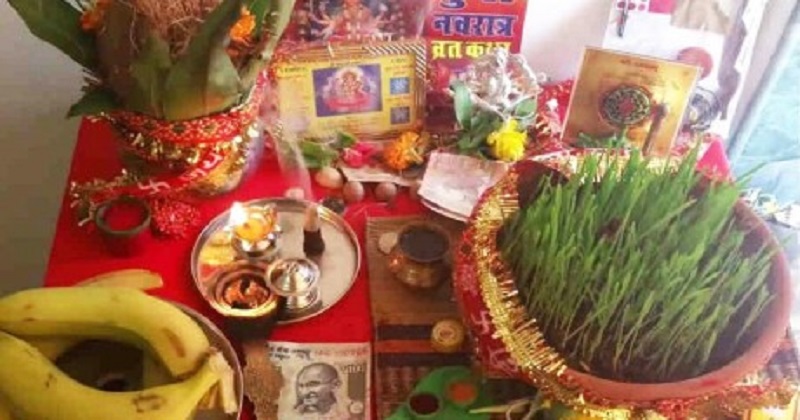
The Ghatasthapana ritual is also known as the Kalash Sthapana or Kalashsthapana in the context of Navratri rituals. Ghatasthapana is a ceremony for invoking Goddess Shakti. This marks the beginning of nine days of celebrations. This puja should be performed according to the correct guidelines and Puja Muhurat. It is auspicious to perform Ghatasthapana in the first third of the day while Pratipada is prevalent. If you cannot practice Pratipada during Abhijit muhurta for whatever reason, you can practice Ghatasthapana instead. The practice of ghatasthapana during Amavasya and during the night is prohibited.

Ghatasthapana Puja Items
- Wide-open Clay Pot to sow Sapta Dhanya
- Clean Soil to sow Sapta Dhanya
- Sapta Dhanya or seeds of seven different grains
- Small clay or brass Pitcher
- Sacred water to fill the Kalash or Ganga Jal
- Sacred thread / Moli / Kalaya
- Scent (perfume)
- Supari (betel nuts)
- Coins to put into the Kalash
- 5 leaves of Ashoka or Mango tree
- A lid to cover the Kalash
- Raw Rice or unbroken rice known as Akshat (?????) to put in the lid
- Unpeeled Coconut
- Red Cloth to warp coconut
- Flowers and Garland preferably marigold
- Durva grass

Ghatasthapana Puja Vidhi
- Make sure the room or space where you are performing the Ghatsthapana is clean.
- Sow seven different types of grains in a pitcher made of mud or copper with soil and fill it with soil. Nowadays people choose single grains, lentils or gram. When grain is sown, Lord Varuna’s mantras are chanted. Any mantra you know especially dedicated to Goddess Shakti can be used if you do not know any Vedic mantras.
- Put another soil set aside and build a thick square or rectangle bed with a thickness of 5 to 7 centimeters in the puja room or area. The grain is planted on this bed as well.
- In the puja room or in the puja area near the thick square of the sand bed, Goddess Durga or other incarnations of Goddess Shakti are installed. Navarna Yantras are placed near the picture of Goddess Durga if any are available. In addition, a pot containing mud is placed nearby.
- The Kalash pot is made from copper, silver, or earthenware – it is filled with water, sandalwood, paste, flowers, durva grass, turmeric rice, betel nuts, five leaves, five gems, or a gold coin. These items are placed in a single pot. The Kalash is usually topped with coconut, but some people choose to use garland instead.
- Flowers and garlands are placed on the pot, painting, or idol. Flowers adorn the pot and painting of the goddess.
- Aarti is performed in the morning and evening. Traditionally, a lamp is left lit for the entire nine-day period.
- During puja, different mantras are chanted depending on the region and the family tradition. Many people choose simple Goddess Durga mantras.
Read more: NAVRATRI 2021: Durga’s nine forms and the Prasad for offering her
- Devotees usually offer Prasad, flowers, and other offerings to Goddess Durga or Shakti while saying, ‘I offer flower (name of flower)’.The sand bed and the sand pot should keep moist. Water is sprinkled to ensure this.
The nine days are all adorned with fresh flowers. - The grains might have grown 3 inches or 5 inches by the tenth day, and these are cut and given as Prasad to family members, friends, and neighbors.

Post Your Comments